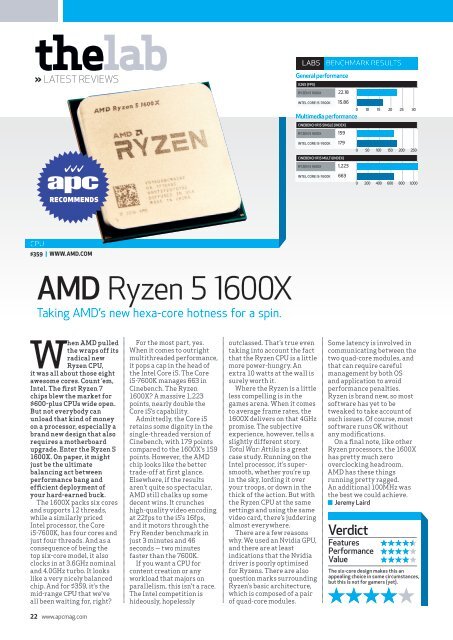Create successful ePaper yourself
Turn your PDF publications into a flip-book with our unique Google optimized e-Paper software.
thelab<br />
» LATEST REVIEWS<br />
LABS BENCHMARK RESULTS<br />
General performance<br />
X265 (FPS)<br />
RYZEN 5 1600X 22.18<br />
INTEL CORE I5-7600K 15.86<br />
0 10 15 20 25 30<br />
Multimedia performance<br />
CINEBENCH R15 SINGLE (INDEX)<br />
RYZEN 5 1600X 159<br />
INTEL CORE I5-7600K 179<br />
0 50 100 150 200 250<br />
CINEBENCH R15 MULTI (INDEX)<br />
RYZEN 5 1600X 1,223<br />
INTEL CORE I5-7600K 663<br />
0 200 400 600 800 1,000<br />
CPU<br />
$359 | WWW.AMD.COM<br />
AMD Ryzen 5 1600X<br />
Taking AMD’s new hexa-core hotness for a spin.<br />
When AMD pulled<br />
the wraps off its<br />
radical new<br />
Ryzen CPU,<br />
it was all about those eight<br />
awesome cores. Count ’em,<br />
Intel. The first Ryzen 7<br />
chips blew the market for<br />
$600-plus CPUs wide open.<br />
But not everybody can<br />
unload that kind of money<br />
on a processor, especially a<br />
brand new design that also<br />
requires a motherboard<br />
upgrade. Enter the Ryzen 5<br />
1600X. On paper, it might<br />
just be the ultimate<br />
balancing act between<br />
performance bang and<br />
efficient deployment of<br />
your hard-earned buck.<br />
The 1600X packs six cores<br />
and supports 12 threads,<br />
while a similarly priced<br />
Intel processor, the Core<br />
i5-7600K, has four cores and<br />
just four threads. And as a<br />
consequence of being the<br />
top six-core model, it also<br />
clocks in at 3.6GHz nominal<br />
and 4.0GHz turbo. It looks<br />
like a very nicely balanced<br />
chip. And for $359, it’s the<br />
mid-range CPU that we’ve<br />
all been waiting for, right?<br />
For the most part, yes.<br />
When it comes to outright<br />
multithreaded performance,<br />
it pops a cap in the head of<br />
the Intel Core i5. The Core<br />
i5-7600K manages 663 in<br />
Cinebench. The Ryzen<br />
1600X? A massive 1,223<br />
points, nearly double the<br />
Core i5’s capability.<br />
Admittedly, the Core i5<br />
retains some dignity in the<br />
single-threaded version of<br />
Cinebench, with 179 points<br />
compared to the 1600X’s 159<br />
points. However, the AMD<br />
chip looks like the better<br />
trade-off at first glance.<br />
Elsewhere, if the results<br />
aren’t quite so spectacular,<br />
AMD still chalks up some<br />
decent wins. It crunches<br />
high-quality video encoding<br />
at 22fps to the i5’s 16fps,<br />
and it motors through the<br />
Fry Render benchmark in<br />
just 3 minutes and 46<br />
seconds — two minutes<br />
faster than the 7600K.<br />
If you want a CPU for<br />
content creation or any<br />
workload that majors on<br />
parallelism, this isn’t a race.<br />
The Intel competition is<br />
hideously, hopelessly<br />
outclassed. That’s true even<br />
taking into account the fact<br />
that the Ryzen CPU is a little<br />
more power-hungry. An<br />
extra 10 watts at the wall is<br />
surely worth it.<br />
Where the Ryzen is a little<br />
less compelling is in the<br />
games arena. When it comes<br />
to average frame rates, the<br />
1600X delivers on that 4GHz<br />
promise. The subjective<br />
experience, however, tells a<br />
slightly different story.<br />
Total War: Attila is a great<br />
case study. Running on the<br />
Intel processor, it’s supersmooth,<br />
whether you’re up<br />
in the sky, lording it over<br />
your troops, or down in the<br />
thick of the action. But with<br />
the Ryzen CPU at the same<br />
settings and using the same<br />
video card, there’s juddering<br />
almost everywhere.<br />
There are a few reasons<br />
why. We used an Nvidia GPU,<br />
and there are at least<br />
indications that the Nvidia<br />
driver is poorly optimised<br />
for Ryzens. There are also<br />
question marks surrounding<br />
Ryzen’s basic architecture,<br />
which is composed of a pair<br />
of quad-core modules.<br />
Some latency is involved in<br />
communicating between the<br />
two quad-core modules, and<br />
that can require careful<br />
management by both OS<br />
and application to avoid<br />
performance penalties.<br />
Ryzen is brand new, so most<br />
software has yet to be<br />
tweaked to take account of<br />
such issues. Of course, most<br />
software runs OK without<br />
any modifications.<br />
On a final note, like other<br />
Ryzen processors, the 1600X<br />
has pretty much zero<br />
overclocking headroom.<br />
AMD has these things<br />
running pretty ragged.<br />
An additional 100MHz was<br />
the best we could achieve.<br />
Jeremy Laird<br />
Verdict<br />
Features<br />
Performance<br />
Value<br />
The six-core design makes this an<br />
appealing choice in some circumstances,<br />
but this is not for gamers (yet).<br />
22 www.apcmag.com


















